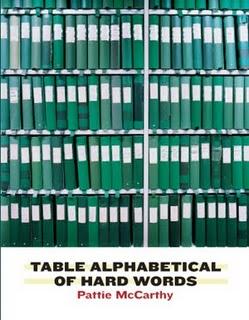Table Alphabetical of Hard Words

Recently, as I was pushing my daughter in her stroller up a hill, a guy in a pickup truck whistled. Pattie McCarthy’s poem “spaltklang: is good broken music” reminded me of this moment. McCarthy describes a new mother who finds her body meaning has been overwritten with a new set of signs:
it’s the stroller, she said, it renders one
invisible, no one will ever look
at me like that again, she said, not
_even him. _
Table Alphabetical of Hard Words tells the story of how we want to believe in the simplicity of signs, even as these signs slip away from us and are ultimately irreducible to their dictionary definitions. Her poems show that “the stroller” does not make “one/invisible,” just as diacritical marks do not always tell us precisely what part of a word matters most.
While reading Table Alphabetical of Hard Words, I found myself drawn by two incongruous impulses: to join McCarthy in an archive outside of our time and to relish in the shape, the feel, the complexity of early modern language and to try to piece together the fragments she had drawn together. The first of these impulses fits neatly with the material project of the collection.
The cover of Table Alphabetical of Hard Words is a repeating yet off-center set of identically bound archival documents, their contents listed but hard to read on the bindings. McCarthy makes her reader enter the archive with her, where she provides etymologies and connections between words while also sending readers outside the text with annotations like “(see usage notes)”. She identifies twenty-first century language as something difficult and tricky, in a different way than the “Hard Words” comprising early word lists and dictionaries: "I don’t understand your euphemistic emoticons, please stop saying important things in code.” We do not have a word list, a key for our own linguistic shortcuts, she suggests in frustration, yet Table Alphabetical of Hard Words also tells the story of what is not said, and McCarthy unpacks only some of her shorthand in her list of sources. Her readers must think outside this text, following traces of allusions and shades of influence.
McCarthy’s language echoes modernists including Virginia Woolf, H. D., Ezra Pound, T. S. Eliot, and especially Gertrude Stein. She draws on Henry Reed’s “Naming of Parts,” and she jarringly blends Medbh McGuckian, Seamus Heaney, and Jenn McCreary’s poems with Old English sources, contemporary references to television shows like NYPD Blue, trial records, and other fragments of language that she pieces together with sometimes playful and always visceral effects. For instance, she notes that Webster’s original dictionary used the long s for bloodsucker, making the word look like bloodfucker. Her first poem, “askew: latelye done to deathe” echoes Howe’s The Europe of Trusts, in which Jonathan Swift’s Stella (Esther Johnson) blends with Shakespeare’s Cordelia: she is given a voice, but still obliterated by her lover.
McCarthy forces her reader to question this search for allusions and origins. If our own markings are so illegible, so meaningless, and misleading to us, how can we read break down words we have lost? If a mother’s body may or may not be read differently because of the diacritical mark of a stroller, how do we know what and how to read on and about the bodies that surround us? Table Alphabetical of Hard Words explodes the one-to-one relationship between words and meanings that are so basic to daily life while demonstrating that bodies and words are both hard to interpret, meaningful in their matter, but tricky, mutable, and often unintelligible.